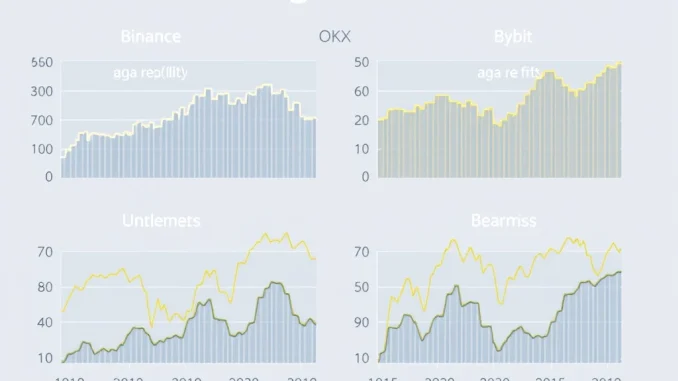
Are you trying to decipher the ever-shifting tides of the cryptocurrency market? One powerful tool in a crypto trader’s arsenal is the BTC long-short ratio. Understanding this metric can provide valuable insights into market sentiment and potential future price movements. Today, we’re diving deep into the latest 24-hour Bitcoin futures long-short ratios, dissecting the data from leading exchanges to give you a clear picture of where the market leans.
Decoding the Bitcoin Long-Short Ratio: A Vital Indicator
Before we jump into the numbers, let’s quickly clarify what the BTC long-short ratio actually represents. In the world of perpetual futures trading, this ratio compares the total volume of traders holding long positions (betting on price increases) against those holding short positions (betting on price decreases). It’s essentially a snapshot of trader sentiment – are more people bullish or bearish on Bitcoin at this moment?
A ratio above 50% long indicates that more traders are positioned for Bitcoin’s price to go up, suggesting a potentially bullish sentiment. Conversely, a ratio below 50% long (meaning above 50% short) suggests a bearish outlook, with more traders anticipating a price decline.
24-Hour BTC Perpetual Futures Long-Short Ratios: The Big Picture
Looking at the aggregate data across major cryptocurrency exchanges, here’s the overall crypto market sentiment for BTC perpetual futures over the last 24 hours:
Total Exchanges: Long 49.45%; Short 50.55%
At first glance, this reveals a slightly bearish leaning in the overall market. The short positions marginally outweigh the long positions, suggesting a cautious or slightly negative sentiment prevailing among traders across all tracked exchanges. However, this is a very slight difference, indicating a relatively balanced market.
Exchange-Specific Insights: Binance, OKX, and Bybit Breakdown
While the overall ratio provides a general market view, drilling down into individual exchanges can offer more granular insights. Let’s examine the BTC long-short ratios on three of the top cryptocurrency exchanges: Binance, OKX, and Bybit.
Binance: The Market Leader’s Perspective
Binance, as the largest cryptocurrency exchange by trading volume, often serves as a bellwether for market trends. Here’s the 24-hour long-short ratio on Binance:
Binance: Long 48.74%; Short 51.26%
Similar to the overall market, Binance also shows a slightly bearish sentiment with short positions exceeding long positions. This reinforces the idea of a cautious approach among traders, even on the leading platform. The difference here is again marginal, indicating a closely contested battle between bulls and bears.
OKX: Gauging Trader Confidence
OKX is another major player in the crypto derivatives space. Let’s see how traders on OKX are positioned:
OKX: Long 49.35%; Short 50.65%
OKX presents a nearly identical picture to both the overall market and Binance. The slight edge for short positions further strengthens the narrative of a slightly bearish or at least non-bullish prevailing sentiment in the short term. It’s crucial to note the consistency across different exchanges, which adds weight to this observation.
Bybit: A Deeper Dive into Derivatives Trading
Bybit is particularly popular among derivatives traders. What does their long-short ratio reveal?
Bybit: Long 48.79%; Short 51.21%
Bybit’s data aligns very closely with Binance, showing almost the same percentages. This consistent trend across all three major exchanges – Binance, OKX, and Bybit – suggests that the slightly bearish sentiment isn’t isolated to one platform but is more broadly reflected across the cryptocurrency trading landscape.
What Does This Data Tell Us About Crypto Market Sentiment?
The consistent slight dominance of short positions across these major exchanges, though not overwhelmingly bearish, indicates a prevailing caution in the market. Several factors could contribute to this sentiment:
- Market Uncertainty: The cryptocurrency market is known for its volatility. Traders might be hesitant to take on significant long positions amidst ongoing economic uncertainties, regulatory concerns, or broader market fluctuations.
- Profit Taking: Following any recent price rallies, some traders might be taking profits and opening short positions to capitalize on potential pullbacks.
- Anticipation of News Events: Upcoming economic data releases, regulatory announcements, or major crypto-related news events could be making traders cautious, leading to a preference for short positions or hedging strategies.
Actionable Insights: How Traders Can Use Long-Short Ratios
Understanding BTC long-short ratios isn’t just about gauging market sentiment; it’s about incorporating this information into your trading strategy. Here are a few actionable insights:
- Confirmation Tool: Use long-short ratios to confirm your own technical or fundamental analysis. If your analysis suggests a potential downturn, and the long-short ratio is also leaning bearish, it can strengthen your conviction.
- Contrarian Indicator (Use with Caution): In highly volatile markets, extreme long-short ratios can sometimes act as contrarian indicators. For example, an excessively high long ratio might suggest an overbought condition, potentially preceding a price correction. Conversely, an extremely high short ratio could indicate oversold conditions. However, using this approach requires careful risk management and additional confirmation signals.
- Risk Management: Be aware of the prevailing market sentiment reflected in long-short ratios. In a slightly bearish market (like the current data suggests), consider adjusting your position sizes or implementing tighter stop-loss orders to manage risk.
- Monitor Trends Over Time: Don’t just look at a single snapshot. Track the Bitcoin futures long-short ratio trends over days and weeks to identify shifts in market sentiment. A gradual increase in long positions could signal growing bullishness, while a persistent rise in short positions might indicate a developing downtrend.
Important Considerations and Caveats
While BTC long-short ratios are valuable, it’s essential to remember they are just one piece of the puzzle. Don’t rely solely on this metric for trading decisions. Always consider these points:
- Exchange Specificity: Ratios can vary slightly across exchanges. Always check data from multiple reputable sources.
- Lagging Indicator: Long-short ratios reflect past and current positioning, not necessarily future price movements. Market sentiment can change rapidly.
- Manipulation Potential: In less liquid markets or on smaller exchanges, long-short ratios might be more susceptible to manipulation. Focus on data from major, reputable exchanges like Binance, OKX, and Bybit.
- Context is Key: Always interpret long-short ratios within the broader context of market conditions, news events, and other technical and fundamental indicators.
Conclusion: Navigating Crypto Markets with Data-Driven Insights
The latest 24-hour BTC long-short ratio data reveals a slightly bearish sentiment prevailing in the Bitcoin futures market. While not dramatically skewed, the consistent slight dominance of short positions across Binance, OKX, and Bybit suggests traders are approaching the market with caution. By understanding and monitoring these ratios, and incorporating them into a comprehensive trading strategy alongside other analyses, you can gain a crucial edge in navigating the volatile and exciting world of cryptocurrency trading. Keep an eye on these metrics, stay informed, and trade wisely!



